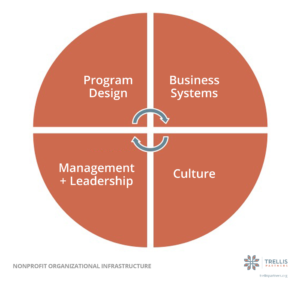The Social Sector and the Term Executive Model
You might not know it from looking at the state of things in the US and around the world, but indicators show that the human condition has improved over the millennia. And institutions around the world continue to work toward its improvement, in particular institutions in the social sector. And in this sector, as we shall see, leaders that follow the “term executive” model have a special role to play.
Governments and private corporations certainly have their roles in the human social economy, but there is one sector that often goes unrecognized—the social sector. It goes by many names–civil society, nonprofit sector, even the third sector because it does what the government sector can’t do and the private sector won’t.
Although taken for granted, a good portion of our humanitarian, environmental, and other social growth is owed to the social sector, especially the nonprofit organizations that carry out the programs. Also called charities, in the US, nonprofits are 501c3 tax exempt organizations that work toward educational, scientific, religious and other charitable purposes to advance the common good.
Nonprofits are and have been deeply woven into the fabric of contemporary society. They have demonstrated an essential role in achieving and sustaining social, environmental, and economic justice across the world. Take, for example, the Human Rights Campaign, which was a leading organization in winning the fight for marriage equality in the US and continues to defend it. Or consider the work of the ACLU in defending civil rights. Or another, Feeding America, the network of more than 200 food banks feeding over 46 million Americans.
Then there are the household names, nonprofit organizations that seem as much a part of the American zeitgeist as big-box stores, and possibly not identified as nonprofit organizations by the average person: Salvation Army, Greenpeace, Red Cross, Planned Parenthood, YMCA, AARP, the Boys and Girls Club of America, Sierra Club, and many more.
Here are some helpful numbers compiled by Classy that help illustrate the power and reach of the nonprofit sector:
- There are an estimated 1.41 million nonprofit organizations in the US.
- Nonprofits contribute approximately $905 billion dollars to the US economy.
- There are approximately nearly 11 million nonprofit employees, about 10% of US employment.
- Around $1.74 trillion was reported as revenue by public charities in 2013.
Nonprofit Quarterly estimates that, “If the global nonprofit sector were a country, it would have the sixteenth largest economy in the world…”
Because the social sector’s role is so great, and nonprofit organizational impact so essential, it’s imperative they thrive and remain resilient in the face of many challenges and demands.
Stakeholders of all kinds, including impact investors and philanthropists, know that in order to achieve societal gains, nonprofits must possess right-sized, stable, strong infrastructures that are able to scale. This includes management strength, intentional culture, effective business systems, and integrated program planning practices.
![]()
Where We’re Coming From
I work with nonprofits to grow organizational resilience so they may be most impactful. Visionary nonprofit leaders have hired me as their term executive, responsible for meeting the organization’s growth, effectiveness, and resilience goals.
I’ve been lucky enough to work with several of these self-aware social sector leaders and their passionate, committed teams. Their candor and engagement gave me unparalleled insight into the needs of nonprofit organizations. I launched Trellis Partners to provide nonprofits embedded supplementary leadership, capacity, and expertise to sustainably resolve the growth, management, and infrastructure challenges that can impede nonprofit effectiveness in achieving social justice gains.
Nature of The Problem
Nonprofits face distinct and complex challenges, even under the best of circumstances. Various conditions can further complicate and entrench those challenges, including:
- Business operations out of synch with program lifecycle, leading to inefficiencies, coverage gaps, and inequities;
- Lack of strategic clarity and inadequate program planning, leading to scope creep, and confusion over priorities;
- Cultural norms that don’t sustain strategic alignment or best business practices;
- Management deficiencies, leading to loss in accountability and erosion in morale;
- Lack of integrated assessment capabilities, short-circuiting feedback loops, and;
- Inability to effectively carry out punctuated business activity, like office moves, changes in administrative model, rapid growth or loss in funding, sudden increase or loss in staff, and more.
Bottom line, a nonprofit’s business needs may distract or detract from the important work it has to do.
The trouble with leadership
In the lean nonprofit environment, leadership and staff are often too over-committed to drive enterprise-level improvements themselves. Social entrepreneurs often do not have the time or capacity to “own the problems” and create custom solutions to organizational challenges. Even growth-minded leadership does not always possess the expertise to drive sustainable organizational change.
As organizations grow they become more complex. Risks increase, challenges arise, and assets fluctuate. If organizational support systems are not integrated and thriving, future growth and excellence are in jeopardy. If leadership feels unprepared to fully meet the complexities of their growing organization, the way forward becomes volatile and opaque.
With already stretched capacity, nonprofit leadership may not want to dedicate resources away from programs and toward the systemic efforts. However, social entrepreneurs must dedicate due attention to the infrastructure that keeps program design, business systems, culture, and leadership resilient and in synch toward their mission.
Utilizing Strategic Consultants
In order to resolve organizational challenges and bring about change, the common contemporary fix is to engage a management or strategy consultant. There is a vast marketplace of consulting firms ready to lend expertise to nonprofit organizations–indeed, Blue Avocado calls it the Philanthropic-Consulting Industrial Complex. The short-term consultant model, however, while essential and irreplaceable for projects throughout the organization, does not often suffice to enable and acculturate enterprise-level improvements.
Consultants are not in a position to institutionalize systems or foster a culture to sustain strategic alignment. Innovator Steve Jobs believed that, “Since they typically swoop in to offer advice and recommendations on a project, but don’t stick around to see the success or failure of their ideas, (consultants are) only seeing a part of the process.”
Trellis Partners’ Term Executive Model
With more than 15 years of proof of concept, Trellis Partners developed the term executive model to provide the intensive systems-level leadership and accountability required for sustainable organizational improvement.
The term executive has a role on the executive team and works with all staff in the day-to-day. S/he takes the lead on dedicated organizational change or growth campaigns.
For a period of up to two years, the term executive is engaged as a regular employee and is dedicated to directing the co-creation of conditions that can sustain organizational effectiveness. To put it bluntly, term executives provide the capacity of a full-time professional executive, yet won’t be on the payroll forever.
In large part by leveraging day-to-day opportunities for improvement, the term executive leads organizational transformation while also capably managing business operations. S/he directs the alignment of strategic components in order to achieve a step increase in impact and organizational resilience.
Term executives work with nonprofit teams to see infrastructure as more than only business systems.
Trellis Partners (re)defines infrastructure to include:
- Program Design – Strategy, goals, timeline, and tactics to deliver on the mission
- Business Systems – Administrative and core functions that support and enable program design and delivery
- Culture – Shared hared history, beliefs, values, and practices
- Management + Leadership – The ways individuals show up to make their contribution to keep the organization functioning toward its mission
As a change leader, the term executive directs a campaign of organizational change until effective systems, planning, leadership, and cultural patterns are created and institutionalized.
The term executive model combines learning and practice to help teams understand their infrastructure and enable them to manage the change necessary to strengthen it
Creating context for results
Organizational challenges and areas for improvement are found throughout the whole organization, so the term executive works at every level of the enterprise. According to transformation designer and speaker Niels Pflaeging, “The problem is in the system—almost always.”
The term executive leverages activity throughout everyday operations and program delivery to promote learning and continuous improvement. To maximize learning, s/he must promote a growth mindset and derive as many lessons as possible from inevitable failures.
And because change is hard, the term executive must remain compassionate with the complex emotional responses of stakeholders. S/he must inspire and drive progress while also leading through plateaus and discouragement. Given the peaks and valleys of change lifecycles, the change leader must be as personally invested in the success of the evolution as other community members.
A focused timeline
The term executive works at every level within the organization, fosters learning, and supports emotional responses. Not only should this punctuated period of intervention be intentional, but also of limited duration. Niels Pflaeging writes, “Profound (organizational) transformation never takes more than 2 years—independent if it’s about an organization with 20 people or 200,000.”
A commitment limited to two years is not an uncommon model in a variety of environments—it’s long enough to make a difference and short enough to keep innovation important. It motivates action toward impact–stakeholders can begin to see results in a short time. It obviates change fatigue, as stakeholders remain aware of the purpose of the change campaign.
The “un-consultants”
Because a term executive is invested in the intervention, s/he feels the effects of the change process alongside staff and other stakeholders. The length of the term allows them the exposure to get to know the organization’s people, processes, and culture while also providing the remove to ask difficult questions and challenge defaults.
Term executives are not short-term, part-time consultants. They are embedded nonprofit executives–full-time, regular employees–for a term of six months to two years to drive change campaigns in pursuit of ongoing organizational effectiveness. They work themselves out of a job. They leave organizations stronger than when they joined them.
Strong deliverables
The term executive works throughout the term so staff and stakeholders will see evidence of that resilience within about two years. As the intervention evolves, the term executive begins to ready organizational staff and systems for new levels of independent practice and increased self-reliance.
By the end of a term executive’s engagement, staff and stakeholders will be equipped with:
- Sufficient and scalable facility, supplies, and equipment
- Efficient and resilient business and core function systems
- Effective organizational management skills and resources
- Improved decision-making and planning processes
- Clarified and aligned roles and responsibilities
- Demonstrable strategic clarity and alignment
- Increased capacity for assessing program impact
- Enabled culture of learning to sustain and continue growth
What’s more, the term executive plans for succession so the staffing structure includes the talent to succeed her or him and capably manage programs and business operations.
Closure
Neither short-term consultants nor permanent staff, the term executive model provides a new alternative to achieve sustainable improvements in nonprofit organizations. Term executives provide expertise from outside the enterprise to deliver the competencies that may not already exist within the workforce. They also bring the critical candor to challenge organizational defaults. And being embedded for a term allows the term executive to understand the mission and culture, develop relationships, and build trust within the organization.
New York Times columnist David Brooks writes, “A person at the edge of inside can be the strongest reformer. This person has the loyalty of a faithful insider, but the judgment of the critical outsider.”
The social sector is a critical part of our world, both in what it has already achieved and the future it promises to help cultivate. Each social enterprise must have a well-functioning infrastructure, effective management, and a culture of learning to sustainably perform the important mission of achieving and sustaining global justice.









